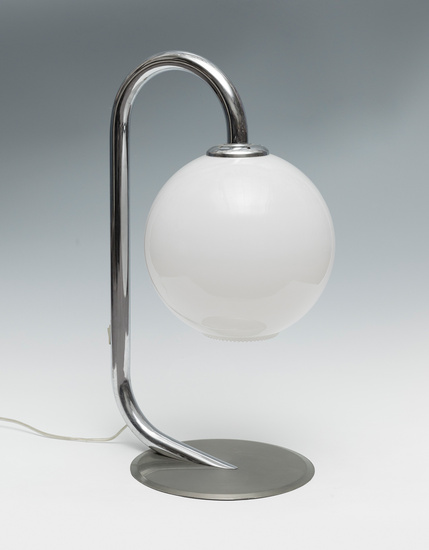Table lamp, Italy in the manner of Franco Albini, 1970s.
Table lamp, Italy in the manner of Franco Albini, 70s.
Chromed metal and glass.
Measurements: 57 x 32 cm.
Table lamp Space Age style, made of chromed metal and glass for the globular lampshade. The piece is inspired by the designs of Franco Albini (1905, Robbiate - 1977, Milan), one of the main figures in the development of rationalist thought in the fields of architectural production, furniture, industrial design and museum design. He graduated in Architecture at the Milan Polytechnic in 1929, later collaborating with the firm of Ponti and Lancia. His collaboration with the editorial staff of Casabella magazine was also fundamental to the development of his thinking, and marked his definitive conversion to rationalism, for which he became a spokesman in the Italian cultural scene. In 1931 he opened his first professional studio in Milan and began working on social housing; this research continued after the war in relation to the opportunities offered by reconstruction, in collaboration with Franca Helg from 1952. In the 1940s, Albini developed his collaboration with Cassina, for whom he designed a series of chairs containing the stylistic elements of his poetics, an activity he continued in the following years with other companies in the sector, including Poggi. Milan and Genoa represent the geographical axis on which Albini left his strongest mark.
HELP
View it on
Estimate
Time
Auction House
Table lamp, Italy in the manner of Franco Albini, 70s.
Chromed metal and glass.
Measurements: 57 x 32 cm.
Table lamp Space Age style, made of chromed metal and glass for the globular lampshade. The piece is inspired by the designs of Franco Albini (1905, Robbiate - 1977, Milan), one of the main figures in the development of rationalist thought in the fields of architectural production, furniture, industrial design and museum design. He graduated in Architecture at the Milan Polytechnic in 1929, later collaborating with the firm of Ponti and Lancia. His collaboration with the editorial staff of Casabella magazine was also fundamental to the development of his thinking, and marked his definitive conversion to rationalism, for which he became a spokesman in the Italian cultural scene. In 1931 he opened his first professional studio in Milan and began working on social housing; this research continued after the war in relation to the opportunities offered by reconstruction, in collaboration with Franca Helg from 1952. In the 1940s, Albini developed his collaboration with Cassina, for whom he designed a series of chairs containing the stylistic elements of his poetics, an activity he continued in the following years with other companies in the sector, including Poggi. Milan and Genoa represent the geographical axis on which Albini left his strongest mark.
HELP



